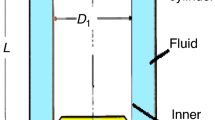Abstract
A multiply connected system for controlling the α-cellulose content in viscose and the viscosity of viscose was developed; it allows separating control actions based on the temperature and amounts in xanthation as a function of the differences in the composition and viscosity of the viscose from the assigned values. Mathematical modeling demonstrated the efficient operation of the system, and the effect of perturbations decreased by 2.8 times for the viscosity and 1.9 times for the composition.
Similar content being viewed by others
References
T. G. Suris et al., Khim. Volokna, No. 5, 25–26 (1986).
A. V. Koval'chuk et al., Khim. Volokna, No. 5, 22–25 (1986).
V. P. Biryukov, Some Principles for Constructing Systems for Control of Manufacturing Processes with a High Level of Uncontrollable Perturbations, Candidate Dissertation, Leningrad (1991).
Z. A. Rogovin, Principles of Chemical Fibre Chemistry and Technology [in Russian], Vol. 1, Khimiya, Moscow (1974).
A. N. Ryauzov, Chemical Fibre Production Technology [in Russian], Khimiya, Moscow (1974).
S. V. Murin and V. P. Biryukov, “Construction of a shaping filter for random signal generation. Problems of strength, reliability, and efficiency,” in: Research at BITTU SGTU, Izd. SGTU, Saratov (2007), pp. 222–225.
G. C. Goodwin, S. F. Graebe, and M. E. Salgado, Control System Design, Prentice Hall, Upper Saddle River NJ (2000).
V. S. Medvedev and V. G. Potemkin, Control System Toolbox, Dialog MIFI, Moscow (1999).
Hubert Kwakernaak and Raphael Sivan, Linear Optimal Control Systems, Wiley-Interscience, New York (1972).
A. G. Aleksandrov, Optimal and Adaptive Systems [in Russian], Vysshaya Shkola, Moscow (1989).
William J. Ray, Methods of Controlling Manufacturing Processes [Russian translation], Mir, Moscow (1983).
C. Ostrem, Introduction to the Stochastic Theory of Control [Russian translation], Mir, Moscow.
K. A. Pupkov and N. D. Egupov, Methods of Classic and Modern Automatic Control Theory [in Russian], MGTU im. N. E. Bauman, Moscow (2004).
V. Streitz, The State Space Method in the Theory of Discrete Linear Control Systems [Russian translation], Nauka, Moscow (1985).
P. V. Kuropatkin, Optimal and Adaptive Systems [in Russian], Vysshaya Shkola, Moscow (1980).
Author information
Authors and Affiliations
Additional information
__________
Translated from Khimicheskie Volokna, No. 1, pp. 57–60, January–February, 2008.
Rights and permissions
About this article
Cite this article
Murin, S.V., Biryukov, V.P. & Artemenko, S.E. Multiply connected system for controlling the composition and viscosity of viscose. Fibre Chem 40, 72–77 (2008). https://doi.org/10.1007/s10692-008-9000-2
Published:
Issue Date:
DOI: https://doi.org/10.1007/s10692-008-9000-2




